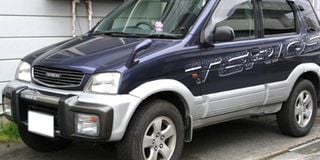Daihatsu Terios takes on Honda HR-V

The Terios’exterior. Although tiny, some people like it for its small engine and four-wheel drive attributes.
Daihatsu Terios also called Toyota Cami and Honda HR-V are both compact Sports Utility Vehicles (SUV)s designed to appeal to the more outdoor fun loving people or young families. The first generation Daihatsu Terios was built between 1997-2005 while Honda HR-V was built from 1999 to 2006.
Daihatsu and Honda built vehicles were meant to be a mini version of bigger SUVs with efficient engine performance, easier parking, reasonable comfort, ample passenger and loading space as well as good multi-terrain accessibility. These two rival models are sold on the Ugandan used car market. Let us examine which one of the above rivals fits the bill.
Performance
Daihatsu Terios’ HC-EJ 1.3 litre petrol engine with multipoint electronic fuel injection and single overhead camshafts (SOHC) is not a very efficient engine. The small engine is quite underpowered and mismatched to the compact four-wheel drive vehicle. When you load the Terios with four passengers and some luggage, it struggles to pick up the pace (accelerate) and fails to deliver the fuel economy typical of a small 1.3 litre engine.
The above situation is worsened if you buy the full time four wheel drive Terios which adds constant load on the engine. Honda HR-V is powered by the 1.6 litre D16A engine which is bigger, faster and yet more economical than the Terios 1.3 litre.
The HR-V engine size is appropriate for the vehicle size and loading capacity making it more efficient than the Terios. The Honda engine has 16 valves and VTEC variable valve timing technology. This innovation uses two camshaft profiles to hydraulically select between valve lifters under its single overhead camshaft (SOHC) drive train.
HR-V’s VTEC system uses electrical and mechanical intervention to adjust the multiple camshaft profiles for low and high engine revolutions. This gives HR-V better high-end power and low end torque and improves the engine power output to achieve faster acceleration and pulling power while enjoying better fuel economy. This will make HR-V attractive to the buyers who may need flexibility to carry passengers and some cargo in town or the highway.
Handling, comfort and safety
Daihatsu Terios’ four wheel drive system lacks the low and high range options so a driver cannot manually adapt to changing off road terrain conditions such as on a slippery muddy road. The small under powered engine can neither climb up steep terrain when fully loaded nor tow a trailer or stranded car. Terios’ road holding on tarmac is good at low speeds, however it feels light and loses grip when driven fast around bends. This is because its higher ground clearance and narrower wheel base give it a poorer centre of gravity. Off-road on corrugated dirt the Terios can only be driven at very low speeds as it feels choppy and sways about.
HR-V drives better on and off-road with varying degrees of success. HR-V’s intelligent transmission the Continuously Variable Transmission (CVT) adapts effortlessly to the different driving conditions and terrain. CVT facilitates a combination of good engine efficiency and vehicle handling while manoeuvring fast around highway bends or cruising uphill or downhill on highways like Mbarara -Masaka. This transmission coupled with the Macpherson independent suspension and a wider wheel base which give HR-V better road holding and handling during highway driving.
The Terios and HR-V are both comfortable and safe cars to drive. They offer a range of comfort and convenience features which include air conditioning, electric mirrors or windows and audio CD entertainment. The HR-V is more spacious and provides sufficient passenger and luggage room. Safety features on both cars include driver airbag, anti locking brakes – ABS, side intrusion beams and retracting seatbelts.
Reliability and resale value
The used Terios and HR-V are both reliable cars if bought at reasonably low mileages not exceeding 80,000km. Beyond 100,000km a buyer has to expect expensive suspension, transmission fluids or timing belt overhaul.
There is a scarcity of new fast moving maintenance (filters) and major replacement parts items for Terios and HR-V in Uganda. This takes away some of the joy in owning one of these cars. As such they tend to have a poor resale value.
Verdict
The Daihatsu Terios gets one star point for good comfort and safety standards. Honda HR-V gets three points for better engine performance, superior handling on and off road as well as good comfort and safety.
Reliability is questionable after 100,000km when the need to replace the major parts emerges and yet they are not readily available in Uganda.




